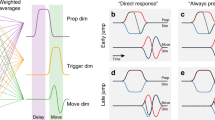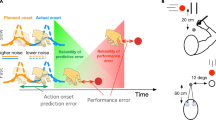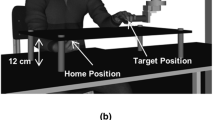Abstract
Manual aiming movements can be amended during their execution. Recent evidence suggests that error detection and correction are based on automatic and even reflexive processing of afferent information. In this study, we wanted to determine whether these processes are affected by the occurrence of successive events requiring adjustments of the originally planned movement. To reach our goal, we used a video-aiming task. For a small proportion of the trials, the cursor moved by the participant was translated laterally by 15 mm (cursor jump) soon after movement initiation. For some of the cursor-jump trials, a second cursor jump occurred 100 ms after the first one and canceled or doubled the initial cursor translation. Results showed that participants were able to cancel or double the size of the correction in response to the second cursor jump. More importantly, in double-jump trials, the correction latency for the first and second cursor jumps did not differ from that of single-jump trials. Moreover, the correction for the second cursor jump blended seamlessly with the correction for the first cursor jump. These observations suggest that the processes leading of a correction for a cursor jump do not interfere with incoming visual information.






Similar content being viewed by others
Notes
It should be remembered that the procedure use to define movement time during data acquisition differed from that used during data analysis, which explains why the movement times reported above appear longer than the upper limit of the target movement time bandwidth.
Gordon et al. (1994) showed that movements initiated from a starting position located along one’s midline had a larger acceleration when aimed to the right than they did when aimed to the left of the starting position because of a larger inertial resistance in the latter (due to a larger involvement of the shoulder) than in the former direction (see also Carey and Otto-de Haart 2001; Mackrous and Proteau 2007 for a similar observation). This difference in inertial resistance is usually compensated by an increase in movement time in the direction of larger inertia (Gordon et al. 1994; Mackrous and Proteau 2007). Conversely, it could be that more accurate and faster movements are made when the position of the target is processed, at least initially, in the same hemisphere as the motor and sensory information of the reaching hand, because of more efficient within- than between-hemisphere visuomotor transmission of target information and/or visual feedback from the hand.
References
Bédard P, Proteau L (2003) On the role of peripheral visual afferent information for the control of rapid video-aiming movements. Acta Psychol 113:99–117
Binsted G, Chua R, Helsen W, Elliott D (2001) Eye-hand coordination in goal-directed aiming. Hum Mov Sci 20:563–585
Brenner E, Smeets JB (2003) Fast corrections of movements with a computer mouse. Spat Vis 16:365–376
Bridgeman B, Lewis S, Heit G, Nagle M (1979) Relation between cognitive and motor-oriented systems of visual position perception. J Exp Psychol Hum Percept Perform 5:692–700
Cameron BD, Franks IM, Enns JT, Chua R (2007) Dual-target interference for the ‘automatic pilot’ in the dorsal stream. Exp Brain Res 181:297–305
Carey DP, Otto-de Haart EG (2001) Hemispatial differences in visually guided aiming are neither hemispatial nor visual. Neuropsychologia 39:885–894
Carson RG, Chua R, Elliott D, Goodman D (1990) The contribution of vision to asymmetries in manual aiming. Neuropsychologia 28:1215–1220
Day BL, Lyon IN (2000) Voluntary modification of automatic arm movements evoked by motion of a visual target. Exp Brain Res 130:159–168
Desmurget M, Pélisson D, Rossetti Y, Prablanc C (1998) From eye to hand: planning goal-directed movements. Neurosci Biobehav Rev 22:761–788
Desmurget M, Epstein CM, Turner RS, Prablanc C, Alexander GE, Grafton ST (1999) Role of posterior parietal cortex in updating reaching movements to a visual target. Nat Neurosci 2:563–567
Fisk JD, Goodale MA (1985) The organization of eye and limb movements during unrestricted reaching to targets in contralateral and ipsilateral visual space. Exp Brain Res 60:159–178
Franklin DW, Wolpert DM (2008) Specificity of reflex adaptation for task-relevant variability. J Neurosci 28:14165–14175
Goodale MA, Pélisson D, Prablanc C (1986) Large adjustments in visually guided reaching do not depend on vision of the hand or perception of target displacement. Nature 320:748–750
Gordon J, Ghilardi MF, Cooper SE, Ghez C (1994) Accuracy of planar reaching movements. II. Systematic extent errors resulting from inertial anisotropy. Exp Brain Res 99:112–130
Gritsenko Y, Yakovenko S, Kalaska JF (2009) Integration of predictive feedforward and sensory feedback signals for online control of visually guided movement. J Neurophysiol 102:914–930
Hesse C, Franz VH (2009) Corrective processes in grasping after perturbations of object size. J Mot Behav 41:253–273
Hodges NJ, Lyons J, Cockell D, Reed A, Elliott D (1997) Hand, space and attentional asymmetries in goal-directed manual aiming. Cortex 33:251–269
Johnson H, Van Beers RJ, Haggard P (2002) Action and awareness in pointing tasks. Exp Brain Res 146:451–459
Liu D, Todorov E (2007) Evidence for the flexible sensorimotor strategies predicted by optimal feedback control. J Neurosci 27:9354–9368
Mackrous I, Proteau L (2007) Specificity of practice results from differences in movement planning strategies. Exp Brain Res 183:181–193
Meyer DE, Abrams RA, Kornblum S, Wright CE, Smith JE (1988) Optimality in human motor performance: ideal control of rapid aimed movements. Psychol Rev 95:340–370
Neggers SFW, Bekkering H (1999) Integration of visual and somatosensory target information in goal-directed eye and arm movements. Exp Brain Res 125:97–107
Neggers SFW, Bekkering H (2000) Ocular gaze is anchored to the target of an ongoing pointing movement. J Neurophysiol 83:639–651
Neggers SFW, Bekkering H (2001) Gaze anchoring to a pointing target is present during the entire pointing movement and is driven by a non-visual signal. J Neurophysiol 86:961–970
Pisella L, Gréa H, Tilikete C, Vighetto A, Desmurget M, Rode G, Boisson D, Rossetti Y (2000) An ‘automatic pilot’ for the hand in human posterior parietal cortex: toward reinterpreting optic ataxia. Nat Neurosci 3:729–736
Prablanc C, Martin O (1992) Automatic control during hand reaching at undetected two-dimensional target displacements. J Neurophysiol 67:455–469
Proteau L, Roujoula A, Messier J (2009) Evidence for continuous processing of visual information in a manual video-aiming task. J Mot Behav 41:219–231
Sarlegna F, Blouin J, Bresciani JP, Bourdin C, Vercher JL, Gauthier GM (2003) Target and hand position information in the online control of goal-directed arm movements. Exp Brain Res 151:524–535
Sarlegna F, Blouin J, Vercher JL, Bresciani JP, Bourdin C, Gauthier GM (2004) Online control of the direction of rapid reaching movements. Exp Brain Res 157:468–471
Saunders JA, Knill DC (2003) Humans use continuous visual feedback from the hand to control fast reaching movements. Exp Brain Res 152:341–352
Saunders JA, Knill DC (2004) Visual feedback control of hand movements. J Neurosci 24:3223–3234
Saunders JA, Knill DC (2005) Humans use continuous visual feedback from the hand to control both the direction and distance of pointing movements. Exp Brain Res 162:458–473
Veyrat-Masson M, Brière J, Proteau L (2010) Automaticity of online control processes in manual aiming. Submitted for publication
Woodworth RS (1899) The accuracy of voluntary movement. Psychol Rev 3(Monograph Suppl):1–119
Acknowledgments
This study was supported by a grant from the Natural Sciences and Engineering Research Council of Canada (NSERC).
Author information
Authors and Affiliations
Corresponding author
Rights and permissions
About this article
Cite this article
Brière, J., Proteau, L. Automatic movement error detection and correction processes in reaching movements. Exp Brain Res 208, 39–50 (2011). https://doi.org/10.1007/s00221-010-2458-1
Received:
Accepted:
Published:
Issue Date:
DOI: https://doi.org/10.1007/s00221-010-2458-1




